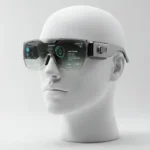Smart Glasses’ future brings together our digital and physical worlds
The future of smart glasses are poised to become an integral part of our daily lives, blurring the lines between the digital and physical worlds. Advancements in augmented reality (AR), artificial intelligence (AI), and miniaturization technologies are paving the way for a future where smart glasses seamlessly integrate into our work, play, and social interactions. Here are some speculations about the future of smart glasses.
Key Trends Shaping the Future of Smart Glasses:
- Enhanced AR Experiences: Expect more immersive and realistic AR overlays that blend seamlessly with the real world. Imagine interactive virtual objects, personalized wayfinding, and real-time language translation, all delivered through your eyewear.
- AI-Powered Personalization: Smart glasses will leverage AI to learn your preferences, habits, and context, delivering tailored experiences and proactive assistance. This could range from personalized recommendations to proactive health monitoring.
- Seamless Integration with Other Devices: Smart glasses will act as a central hub, seamlessly connecting with smartphones, smart homes, and other IoT devices. This interconnected ecosystem will enable a more holistic and intuitive user experience.
- Industry-Specific Applications: Smart glasses will find specialized applications in various industries, such as healthcare, manufacturing, and education. From remote surgery guidance to on-site training and maintenance support, smart glasses will revolutionize how we work and learn.
- Privacy and Security: As smart glasses become more integrated into our lives, addressing privacy and security concerns will be paramount. Robust encryption, secure data storage, and user-centric privacy controls will be essential for widespread adoption.
What’s Coming in the Future of Smart Glasses?
The trajectory of smart glasses points towards sleeker designs, more powerful processors, and increasingly sophisticated software. Here’s a glimpse into what we can expect:
- Improved Displays: Current smart glasses often feature small displays or rely on smartphone screens. The future will likely bring higher-resolution micro-LED or holographic displays that offer a wider field of view and a more immersive augmented reality (AR) experience.
- Enhanced Sensors and AI: Expect more advanced sensors, including better cameras, depth sensors, and even bio-sensors. Coupled with artificial intelligence (AI), these glasses will understand our environment and our needs better, offering context-aware information and assistance.
- Seamless Integration: Future smart glasses will strive for a more natural and less obtrusive design, potentially resembling regular eyewear. Connectivity with smartphones (both iOS and Android) will become even tighter, offering seamless notifications, media control, and data sharing.
- Extended Battery Life: One of the current limitations is battery life. Advancements in battery technology and power efficiency will be crucial for the widespread adoption of smart glasses.
- New Interaction Methods: Beyond voice commands and touch controls on the frame, we might see the integration of eye-tracking, gesture recognition, and even neural interfaces for more intuitive interaction.
The Future is Bright
Despite these challenges, the future of smart glasses is bright. As technology continues to advance, we can expect to see increasingly sophisticated and integrated devices that enhance our lives in countless ways. From personalized experiences to transformative applications in various industries, smart glasses are poised to reshape our interaction with the digital world and redefine the boundaries of human potential. Sources and related content
Best Use Cases for Smart Glasses
The potential applications of smart glasses are vast. Here are some of the most promising:
- Navigation and Information: Imagine real-time directions overlaid on your vision while walking or cycling, or instant access to information about landmarks and points of interest.
- Communication: Hands-free calling, messaging, and video conferencing will become more convenient and less intrusive.
- Photography and Videography: Capturing moments from your point of view without needing to hold a phone or camera.
- Gaming and Entertainment: Immersive AR games and media experiences that blend the digital and physical worlds.
- Enterprise and Industry: Providing workers with hands-free access to instructions, schematics, and remote assistance, improving efficiency and safety in fields like manufacturing, healthcare, and logistics.
- Accessibility (EAT Focus): Smart glasses hold immense potential for individuals with disabilities. They can provide real-time text-to-speech or speech-to-text capabilities, object recognition for the visually impaired, and hands-free control of devices for those with motor impairments. For example, a user with limited mobility could use eye-tracking to control a smart home or communication device.
EAT Considerations:
Smart glasses could integrate with existing EAT solutions, offering a more discreet and versatile way to interact with assistive technologies. Imagine controlling a wheelchair or environmental control system through subtle eye movements or voice commands relayed through smart glasses.
Troubleshooting Common Problems With the Future of Smart Glasses
While the future is bright, current and near-future smart glasses may come with their share of issues:
- Battery Drain: Limit usage of power-intensive features like continuous video recording or augmented reality overlays. Ensure glasses are fully charged before extended use.
- Connectivity Issues: Check Bluetooth and Wi-Fi connections. Ensure your smartphone is within range and the smart glasses app is running and up-to-date.
- Software Glitches: Restart your smart glasses and the companion app. Check for software updates from the manufacturer.
- Display Problems: Ensure the display is properly calibrated and brightness levels are adjusted appropriately. Clean the lens carefully.
- Comfort and Fit: Experiment with different nose bridge sizes or adjustment mechanisms if available. Take breaks from wearing the glasses if they feel uncomfortable.
If problems persist, consult the manufacturer’s support website or contact their customer service.
Frequently Asked Questions (FAQ) About The Future of Smart Glasses
Q: Will smart glasses replace smartphones?
A: It’s unlikely they will completely replace smartphones in the near future. Instead, they will likely act as a complementary device, offering hands-free access to specific functionalities.
Q: Are smart glasses safe to wear for extended periods?
A: As with any technology, it’s advisable to use smart glasses in moderation. Be mindful of potential eye strain and take breaks as needed. Research on the long-term effects is ongoing.
Q: How much will future smart glasses cost?
A: Prices are expected to decrease as the technology matures and becomes more widely adopted. However, cutting-edge features and premium brands will likely still command higher prices.
Q: What about privacy concerns with smart glasses?
A: Privacy is a significant consideration. Manufacturers are working on features and guidelines to ensure user data is protected. Users should also be aware of their surroundings and be responsible in how they use features like cameras.
Q: Will smart glasses work with both iPhone and Android devices?
A: Most manufacturers aim for cross-platform compatibility, but specific features and integration levels may vary between iOS and Android. Check the product specifications for details.
The future of smart glasses is brimming with potential. As the technology evolves, we can expect these devices to become more integrated into our lives, offering a blend of convenience, information, and accessibility for everyone, regardless of their mobile operating system. For individuals who rely on Electronic Assistive Technology, smart glasses represent an exciting frontier in enhancing independence and quality of life.
Additional Helpful Content:
- Here are some details about smart glasses — What are Smart Glasses?
- Whare are the benefits of wearing smart glasses? – Benefits of Wearing Smart Glasses
- Use your smart glasses to navigate using GPS – Smart Glasses With GPS and Navigation Services
- AI in smart glasses – AI Smart Glasses: Real-time Translation & Enhanced Vision
- Enterprise Solutions for Smart Glasses – Smart Glasses for Business: Enterprise AR Solutions
Authoritative Sources:
- TechCrunch: https://techcrunch.com/ – Stay updated on the latest tech trends, including wearables and AR/VR.
- The Verge: https://www.theverge.com/ – Offers in-depth reviews and news on consumer electronics.




